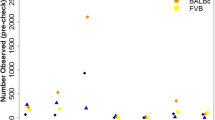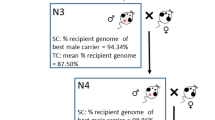Abstract
The development of congenic mouse strains is the principal approach for confirming and fine mapping quantitative trait loci, as well as for comparing the phenotypic effect of a transgene or gene-targeted disruption between different inbred mouse strains. The traditional breeding scheme calls for at least nine consecutive backcrosses before establishing a congenic mouse strain. Recent availability of genome sequence and high-throughput genotyping now permit the use of polymorphic DNA markers to reduce this number of backcrosses, and empirical data suggest that marker-assisted breeding may require as few as four backcrosses. We used simulation studies to investigate the efficiency of different marker-assisted breeding schemes by examining the trade-off between the number of backcrosses, the number of mice produced per generation, and the number of genotypes per mouse required to achieve a quality congenic mouse strain. An established model of crossover interference was also incorporated into these simulations. The quality of the strain produced was assessed by the probability of an undetected region of heterozygosity (i.e., “gaps”) in the recipient genetic background, while maintaining the desired donor-derived interval. Somewhat surprisingly, we found that there is a relatively high probability for undetected gaps in potential breeders for establishing a congenic mouse strain. Marker-assisted breeding may decrease the number of backcross generations required to generate a congenic strain, but only additional backcrossing will guarantee a reduction in the number and length of undetected gaps harboring contaminating donor alleles.






Similar content being viewed by others
References
Beck JA, Lloyd S, Hafezparast M, Lennon-Pierce M, Eppig JT, et al. (2000) Genealogies of mouse inbred strains. Nat Genet 24: 23–25
Bennett B (2000) Congenic strains developed for alcohol- and drug-related phenotypes. Pharmacol Biochem Behav 67: 671–681
Bennett B, Johnson TE (1998) Development of congenics for hypnotic sensitivity to ethanol by QTL-marker-assisted counter selection. Mamm Genome 9: 969–974
Bergman ML, Duarte N, Campino S, Lundholm M, Motta V, et al. (2003) Diabetes protection and restoration of thymocyte apoptosis in NOD Idd6 congenic strains. Diabetes 52: 1677–1682
Blank RD, Campbell GR, Calabro A, D’Eustachio P (1988) A linkage map of mouse chromosome 12: localization of Igh and effects of sex and interference on recombination. Genetics 120: 1073–1083
Brockmann GA, Bevova MR (2002) Using mouse models to dissect the genetics of obesity. Trends Genet 18: 367–376
Brodnicki TC, McClive P, Couper S, Morahan G (2000) Localization of Idd11 using NOD congenic mouse strains: elimination of Slc9a1 as a candidate gene. Immunogenetics 51: 37–41
Brodnicki TC, Quirk F, Morahan G (2003) A susceptibility allele from a non-diabetes-prone mouse strain accelerates diabetes in NOD congenic mice. Diabetes 52: 218–222
Broman KW, Rowe LB, Churchill GA, Paigen K (2002) Crossover interference in the mouse. Genetics 160: 1123–1131
Burt RA, Marshall VM, Wagglen J, Rodda FR, Senyschen D, et al. (2002) Mice that are congenic for the char2 locus are susceptible to malaria. Infect Immun 70: 4750–4753
Collins SC, Wallis RH, Wallace K, Bihoreau MT, Gauguier D (2003) Marker-assisted congenic screening (MACS): a database tool for the efficient production and characterization of congenic lines. Mamm Genome 14: 350–356
Crabbe JC (2002) Alcohol and genetics: new models. Am J Med Genet 114: 969–974
Esteban LM, Tsoutsman T, Jordan MA, Roach D, Poulton LD, et al. (2003) Genetic control of NKT cell numbers maps to major diabetes and lupus loci. J Immunol 171: 2873–2878
Estill SJ, Garcia JA (2000) A marker assisted selection protocol (MASP) to generate C57BL/6J or 129S6/SvEvTac speed congenic or consomic strains. Genesis 28: 164–166
Fortin A, Stevenson MM, Gros P (2002) Complex genetic control of susceptibility to malaria in mice. Genes Immun 3: 177–186
Foss E, Lande R, Stahl FW, Steinberg CM (1993) Chiasma interference as a function of genetic distance. Genetics 133: 681–691
Frisch M, Melchinger AE (2001) The length of the intact donor chromosome segment around a target gene in marker-assisted backcrossing. Genetics 157: 1343–1356
Grattan M, Mi QS, Meagher C, Delovitch TL (2002) Congenic mapping of the diabetogenic locus Idd4 to a 5.2-cM region of chromosome 11 in NOD mice: identification of two potential candidate subloci. Diabetes 51: 215–223
Hanson WD (1959) Early generation analysis of lengths of heterozygous chromosome segments around a locus held heterozygous with backcrossing or selfing. Genetics 44: 833–837
Hospital F (2001) Size of donor chromosome segments around introgressed loci and reduction of linkage drag in marker-assisted backcross programs. Genetics 158: 1363–1379
Hospital F, Charcosset A (1997) Marker-assisted introgression of quantitative trait loci. Genetics 147: 1469–1485
Hospital F, Chevalet C, Mulsant P (1992) Using markers in gene introgression breeding programs. Genetics 132: 1199–1210
Hudgins CC, Steinberg RT, Klinman DM, Reeves MJ, Steinberg AD (1985) Studies of consomic mice bearing the Y chromosome of the BXSB mouse. J Immunol 134: 3849–3854
Iakoubova OA, Olsson CL, Dains KM, Ross DA, Andalibi A, et al. (2001) Genome-tagged mice (GTM): two sets of genome-wide congenic strains. Genomics 74: 89–104
Kauppi L, Jeffreys AJ, Keeney S (2004) Where the crossovers are: recombination distributions in mammals. Nat Rev Genet 5: 413–424
Koudande OD, Iraqi F, Thomson PC, Teale AJ, van Arendonk JA (2000) Strategies to optimize marker-assisted introgression of multiple unlinked QTL. Mamm Genome 11: 145–150
Lamhamedi-Cherradi SE, Boulard O, Gonzalez C, Kassis N, Damotte D, et al. (2001) Further mapping of the Idd5.1 locus for autoimmune diabetes in NOD mice. Diabetes 50: 2874–2878
Lander ES, Schork NJ (1994) Genetic dissection of complex traits. Science 265: 2037–2048
Laporte C, Ballester B, Mary C, Izui S, Reininger L (2003) The Sgp3 locus on mouse chromosome 13 regulates nephritogenic gp70 autoantigen expression and predisposes to autoimmunity. J Immunol 171: 3872–3877
Leiter EH, (2002) Mice with targeted gene disruptions or gene insertions for diabetes research: problems, pitfalls, and potential solutions. Diabetologia 45: 296–308
Lin S, Speed TP (1996) Incorporating crossover interference into pedigree analysis using the chi 2 model. Hum Hered 46: 315–322
Markel P, Shu P, Ebeling C, Carlson GA, Nagle DL, et al. (1997) Theoretical and empirical issues for marker-assisted breeding of congenic mouse strains. Nat Genet 17: 280–284
McDevitt HO (2000) Discovering the role of the major histocompatibility complex in the immune response. Annu Rev Immunol 18: 1–17
Montagutelli X (2000) Effect of the genetic background on the phenotype of mouse mutations. J Am Soc Nephrol 11: Suppl 16, S101–105
Moore KJ, Nagle DL (2000) Complex trait analysis in the mouse: The strengths, the limitations and the promise yet to come. Annu Rev Genet 34: 653–686
Morahan G, Morel L (2002) Genetics of autoimmune diseases in humans and in animal models. Curr Opin Immunol 14: 803–811
Nadeau JH (2001) Modifier genes in mice and humans. Nat Rev Genet 2: 165–174
Nadeau JH, Singer JB, Matin A, Lander ES (2000) Analysing complex genetic traits with chromosome substitution strains. Nat Genet 24: 221–225
Ochiai Y, Tamura Y, Saito Y, Matsuki A, Wakabayashi Y, et al. (2003) Mapping of genetic modifiers of thymic lymphoma development in p53-knockout mice. Oncogene 22: 1098–1102
Podolin PL, Denny P, Lord CJ, Hill NJ, Todd JA, et al. (1997) Congenic mapping of the insulin-dependent diabetes (Idd) gene, Idd10, localizes two genes mediating the Idd10 effect and eliminates the candidate Fcgr1. J Immunol 159: 1835–1843
Rogner UC, Avner P (2003) Congenic mice: cutting tools for complex immune disorders. Nat Rev Immunol 3: 243–252
Santiago-Raber ML, Baccala R, Haraldsson KM, Choubey D, Stewart TA, et al. (2003) Type-I interferon receptor deficiency reduces lupus-like disease in NZB mice. J Exp Med 197: 777–788
Serreze DV, Chapman HD, Varnum DS, Hanson MS, Reifsnyder PC, et al. (1996) B lymphocytes are essential for the initiation of T cell-mediated autoimmune diabetes: analysis of a new “speed congenic” stock of NOD.Ig mu null mice. J Exp Med 184: 2049–2053
Silver LM (1995) Mouse genetics: concepts and applications (New York: Oxford University Press)
Singer JB, Hill AE, Burrage LC, Olszens KR, Song J, et al. (2004) Genetic dissection of complex traits with chromosome substitution strains of mice. Science 304: 445–448
Snell GD (1948) Methods for the study of histocompatibility genes. J Genet 49: 87–108
Stam P, Zeven AC (1981) The theoretical proportion of the donor genome in near-isogenic lines of self-fertilizers bred by backcrossing. Euphytica 30: 227–238
Tsuchihashi Z, Dracopoli NC (2002) Progress in high throughput SNP genotyping methods. Pharmacogenomics J 2: 103–110
Visscher PM (1999) Speed congenics: accelerated genome recovery using genetic markers. Genet Res 74: 81–85
Visscher PM, Haley CS, Thompson R (1996) Marker-assisted introgression in backcross breeding programs. Genetics 144: 1923–1932
Wakeland E, Morel L, Achey K, Yui M, Longmate J (1997) Speed congenics: a classic technique in the fast lane (relatively speaking). Immunol Today 18: 472–477
Weil MM, Brown BW, Serachitopol DM (1997) Genotype selection to rapidly breed congenic strains. Genetics 146: 1061–1069
Winer S, Astsaturov I, Gaedigk R, Hammond-McKibben D, Pilon M, et al. (2002) ICA69(null) nonobese diabetic mice develop diabetes, but resist disease acceleration by cyclophosphamide. J Immunol 168: 475–482
Wither JE, Lajoie G, Heinrichs S, Cai YC, Chang N, et al. (2003) Functional dissection of lupus susceptibility loci on the New Zealand black mouse chromosome 1: evidence for independent genetic loci affecting T and B cell activation. J Immunol 171: 1697–1706
Acknowledgments
The authors thank R.C.A. Symons for advice and comments. This work was supported by NIH grant GM59506-01.
Author information
Authors and Affiliations
Corresponding author
Electronic Supplementary Material
Rights and permissions
About this article
Cite this article
Armstrong, N.J., Brodnicki, T.C. & Speed, T.P. Mind the gap: analysis of marker-assisted breeding strategies for inbred mouse strains. Mamm Genome 17, 273–287 (2006). https://doi.org/10.1007/s00335-005-0123-y
Received:
Accepted:
Published:
Issue Date:
DOI: https://doi.org/10.1007/s00335-005-0123-y




